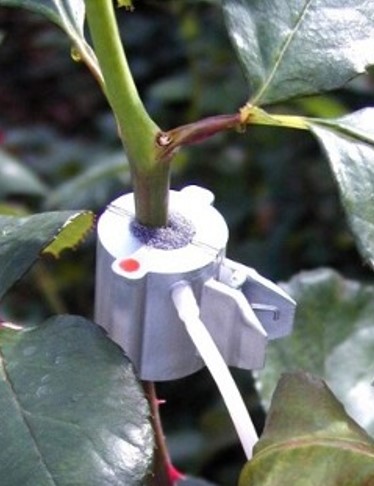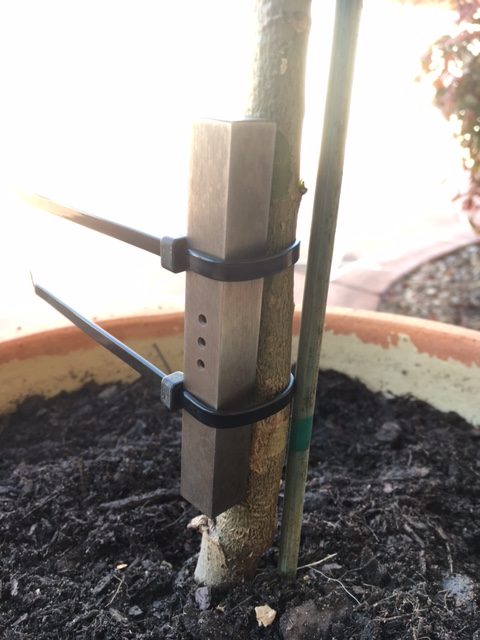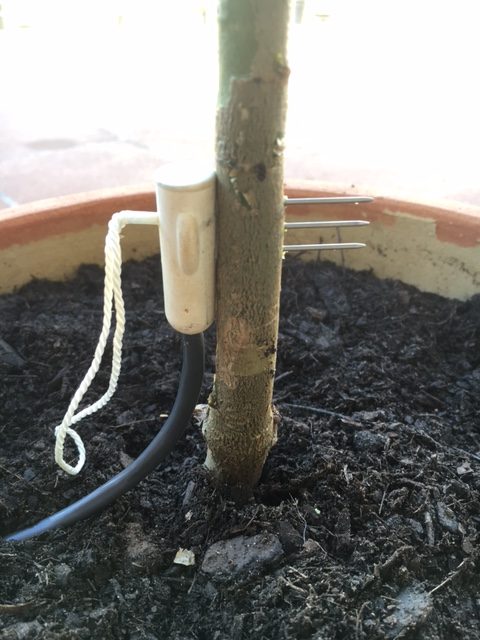measuring sap flow in small stems, branches and petioles
Most sap flow research is conducted on large, woody trees such as eucalypts, pines and oaks, or horticultural species such as oranges, kiwi fruits and grape vines.
Occasionally, researchers, and even growers, need to measure sap flow on smaller stems, branches or even petioles. This application note demonstrates how sap flow can be measured on small stems, the sensors that are required, and presents some example data.
measuring stems, branches or petioles less than 10mm in diameter
Measuring sap flow on the smallest of stems, branches or petioles, is possible with the SF-4 and SF-5 sap flow sensors. These sensors are also known as collar, or wrap around, sap flow sensors as they do not actually penetrate inside of the plant’s tissue but rather wrap around the outside of the stem (Figure 1).
The SF-4 and SF-5 sap flow sensors have a symmetrical allocation of temperature sensors in relation to the heater (Figure 2). That is, there is a heater element located between an upper and lower temperature sensor that all sit flush, and tightly, against the stem, branch or petiole. The temperature difference between the upper and lower temperature sensors is zero at no flow, and it is increasing with the sap flow acceleration.
The voltage signal from the sap flow sensors is positive, zero or negative, depending on the direction of flow. The higher the flow, the greater the output signal. With small scale lysimeters, the output signal can be calibrated to give volumetric sap flow and transpiration rates for specific plant species. Alternatively, data can be analysed as a proportion of maximum sap flow. That is, maximum sap flow, or the highest output voltage signal, is 100% sap flow and all remaining data are corrected against this value.

Figure 2. A schematic of the SF-4 and SF-5 sap flow sensors showing the location of the heater element and upper and lower temperature sensors.
Correct installation of the SF-4 and SF-5 is critical in collecting accurate sap flow data. The sensors are installed easily enough by simply clipping the collar tightly around the stem. However, it is imperative that the heater element and temperature sensors are firmly installed against the plant’s stem.
The SF-4 model is suitable for stems in the size range between 1mm and 5mm; whereas the SF-4 model is suitable for stems in the size range between 4mm and 10mm. The SF-4 model is therefore suitable for petioles, twigs and the smallest of stems. The SF-5 model is more suited to larger stems and branches.
Vigilant maintenance is also critical in collecting accurate sap flow data with the SF-4 and SF-5 models. As these sap flow sensors are installed as a collar around a growing, living tissue, it is important that they are checked regularly to ensure correct installation. On rapidly growing plants, it is possible for the stem to become too large for the sap flow sensor. Therefore, the sensor will need to be moved to a smaller diameter stem. Also, as heat is applied regularly to the stem, a callous can form on the stem and this will affect the voltage output signal from the temperature sensor as well as the amount of heat that can be applied to the stem. For this reason, the sensor should be periodically moved to a fresh stem segment.
Figure 3 shows several days of sap flow data from a SF-4 sensor installed on a small diameter tomato plant (Solanum lycopersicum) stem. Sap flow was measured at a 5-minute logging interval. The data over the first few days is very good. However, by the second last day there is a large amount of noise in the voltage output signal. By the last day of this data set, the noise from the voltage output signal is extreme. In this case, the plant had grown rapidly and the sensor was no longer a suitable size for the stem. Also, after the sensor was removed from the stem, a callous had formed. Therefore, the second and last day of this data set cannot be used for data analysis or interpretation.
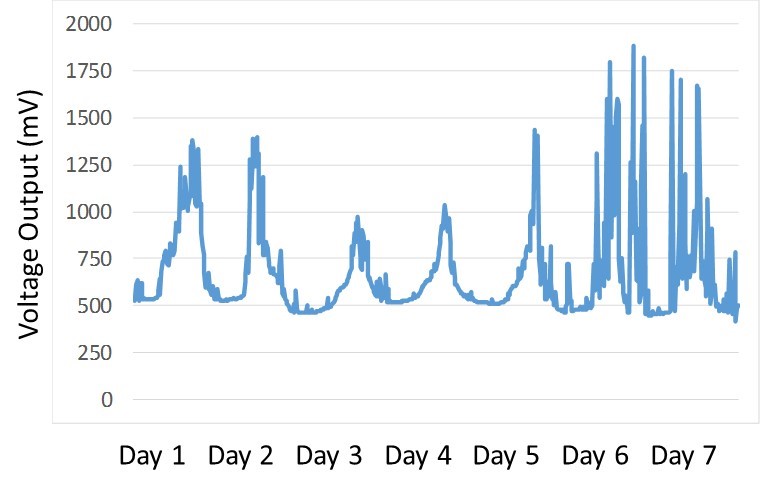
Figure 3. An example data set, over 7 days, from the SF-4 sap flow sensor installed on a tomato plant. The data is the raw voltage output from the sensor.
measuring stems or branches greater than 10mm in diameter
Stems greater than 10mm in diameter can be measured with the Implexx Sap Flow Sensor (Figure 4). The Implexx Sap Flow Sensor is a three-needle sensor where, like the SF-4 and SF-5 sensors, there is a heater element in the middle needle and temperature sensors in the top and bottom needles.
The needles of the Implexx Sap Flow Sensor are 1.27mm in diameter however it is recommended that the minimum stem size that can be measured is 10mm in diameter.
This is because of the wounding effect that is caused by drilling holes into the stem to insert the Implexx Sap Flow Sensor needles.
If the stem was smaller than 10mm in diameter, then, effectively, the drill hole covers too much of the xylem and there is no longer any conducting tissue and sap flow.
The drill guide to install the Implexx Sap Flow Sensor can be attached to the stem by cable ties (Figure 5). It is critical to ensure that the holes are aligned with the centre of the stem.
The Implexx Sap Flow Sensor needles are 30mm in length with temperature sensors located at 10 mm and 20 mm from the tip of the needles.
Known as the outer, middle and inner measurement points, respectively, any one of these points can be used to measure sap flow in a small stem (Figure 6).
Insulating the sensor from external heat and solar radiation is critical for accurate measurements.
We recommend wrapping an insulating material, such as that used in buildings, around the sensor and then wrapping aluminium foil around the insulating material (Figure 7).
Figure 8 is example data from a 1.5m tall Sydney Blue Gum (Eucalyptus saligna) sapling.
The Implexx Sap Flow Sensor was installed approximately 20cm height from the soil surface where the stem diameter was 1.21cm.
Unlike the SF-4 and SF-5 wrap around sensors, the Implexx Sap Flow Sensor can potentially be installed for longer periods of time than just one week.
Figure 8 displays around 11 days of data however the sensor can potentially be left installed for several months. It is recommended to check the wounding around the needles and installation does not become too large as this will affect the accuracy of the sap flow data.
The data displayed in Figure 8 shows how sap flow can vary quite significantly even over an 11 day period. At the start of the measurement period the weather was cool and cloudy. Then, there was about 5 days of fine, sunny and warm weather. Over the last two days of the measurement period, the weather again turned cloudy and cool. This variation is captured nicely in the sap flow data.
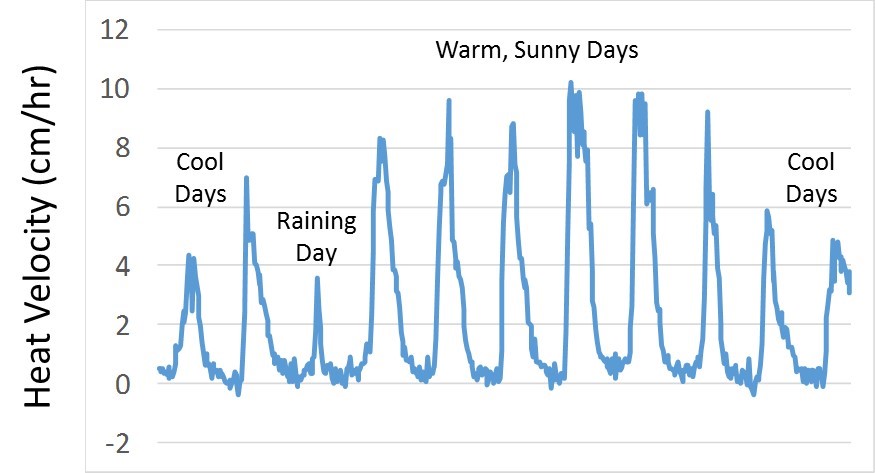
Figure 8. An 11 day data set of heat velocity data from an Implexx Sap Flow Sensor installed in a Sydney Blue Gum sapling.
conclusion
It is possible to measure small stems, branches and petioles with diameters as narrow as 1mm with the Implexx Sap Flow Sensor, SF-4 and SF-5 sap flow sensors. For larger stems, the Implexx Sap Flow Sensor is ideal. For stems less than 10mm in diameter, the SF-4 and SF-5 sensors should be deployed.

